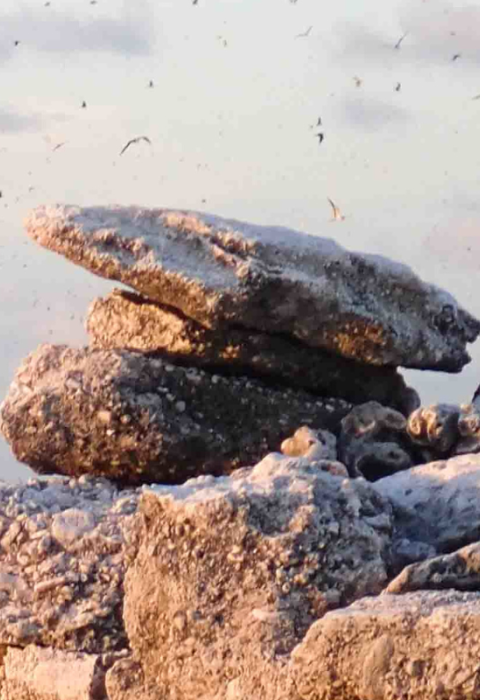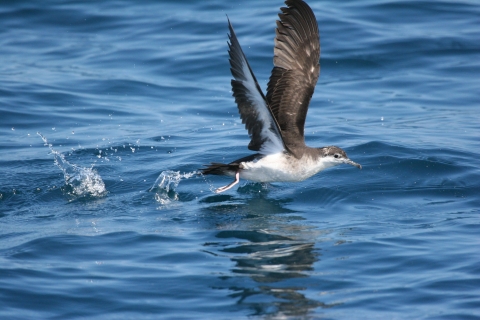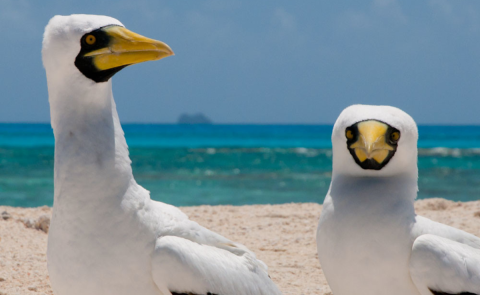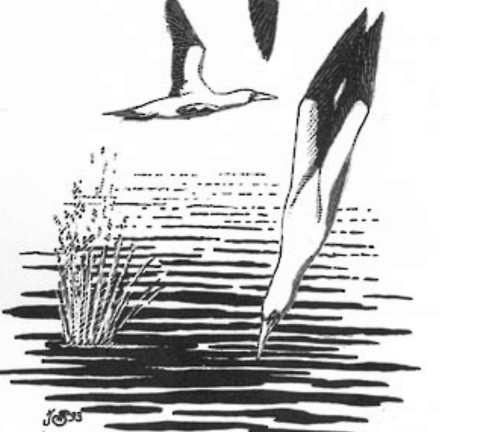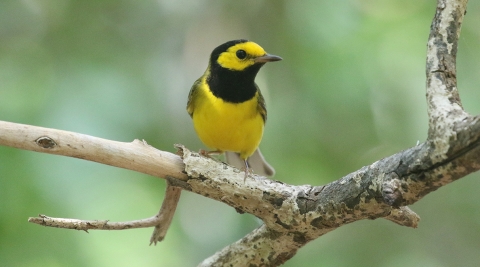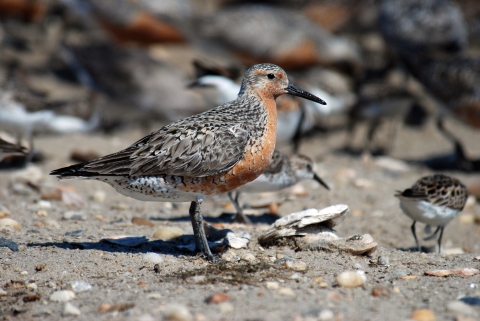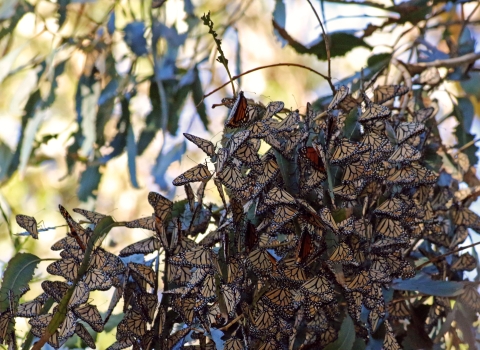Laissez les bon temps voler. Let the good times fly.
In the Gulf of Mexico, not far from a major Mardi Gras hub of the United States, you’ll find many migratory bird species. But they aren’t looking for beads or a good time in the Big Easy.
These birds are looking for food!
There are four potential routes, called flyways, that migratory birds take through North America—Central, Mississippi, Atlantic, and Pacific. All the flyways, except for the Pacific, pass through the Gulf of Mexico. The diversity of habitats in the coastal areas of the Gulf, from marsh edges and mudflats to open bays and nearshore ocean waters, offer a variety and abundance of food sources for migratory birds.
Some species may spend a few days in the Gulf gorging on the delicacies the area offers. Po’boys, gumbo, and jambalaya might come to mind, but the birds prefer mulberries, marine worms, fly larvae, and flying fish. Others spend the entire winter in the Gulf building up their fat reserves for their long migrations in the spring.
Many birds fly hundreds or thousands of miles to reach their final destinations while migrating. They’ll stop to rest and refuel just like you would on a long road trip. These stopover sites, and other areas of the Gulf of Mexico, are favorites for many birds migrating from Central and South America.
Flying across an ocean is quite the workout. By the time these birds reach the Gulf of Mexico, most have lost the fat they stored up for the journey. At stopovers, they need to eat as much as they can, as quickly as they can, to replenish their fat reserves in order to complete their migrations.
It’s a feast!
So, whether it’s for a short amount of time or an entire season, check out a few of the migratory birds you might find in the Gulf of Mexico and what they are eating!
Audubon’s Shearwater (Puffinus lherminieri)
Audubon’s shearwater is a seabird often found in the Gulf of Mexico from April to November. There is still a lot to learn about their migration patterns, but experts suspect that they regularly move towards the northwest Atlantic outside of nesting season. They breed on cliffs, rocky crevices on islands throughout the Caribbean. Audubon’s shearwaters are considered “pickers” and eat foods on the water’s surface—mainly fish, squid, and crustaceans. This species is one of many injured during the 2010 Deepwater Horizon oil spill. Audubon’s shearwater is considered a Bird of Conservation Concern: without additional conservation action they are likely to become threatened or endangered under the Endangered Species Act.
Masked Booby (Sula dactylatra)
Named for the dark “mask” around its eyes and beak, the masked booby is a seabird that breeds on islands throughout the Caribbean and southern Gulf of Mexico. It is commonly spotted in the Gulf and has been seen as far north as North Carolina. Their migration patterns are not clearly defined, and scientists believe that some individuals may be year-round residents.
Masked boobies mainly feed on flying fish. Their feeding tactics are fun to watch as they dive headfirst into the water searching for fish. Masked boobies were injured during the 2010 Deepwater Horizon oil spill and are vulnerable to development and predators on the islands where they breed.
Summer Tanager (Piranga rubra)
The summer tanager is a highly migratory songbird. Summer tanagers breed throughout North America, from California to Florida, and spend their winters in central and northern South America. Summer tanagers migrate at night, and during their spring and fall migrations, they stop in habitats along the Gulf of Mexico to rest and refuel. Their flight range is dependent on how much fat they accumulate; some travel nearly 500 miles. Those with longer journeys must eat as much as they can, as quickly as they can, during their stopovers to regain any fat they lost during the first part of their flight. Summer tanagers eat bees, wasps, and fruits such as mulberries and blackberries. They don’t stay at stopover locations for long. Most summer tanagers will continue their migratory flights two to three hours after sunset on the same day they arrive.
Hooded Warbler (Setophaga citrina)
The hooded warbler, named for the appearance of “hood” around its head, is a migratory songbird that breeds in the eastern United States and southern Canada. Hooded warblers spend their winters in southern Mexico, northern Central America, and the Caribbean. Like the summer tanager, hooded warblers migrate at night and must regain fat when they stop along the Gulf of Mexico. They mainly feed on flying insects and spiders. The populations of many songbirds are decreasing, but hooded warblers are increasing. Their breeding range is expanding northward which scientists believe may be due to temperature changes associated with climate change climate change
Climate change includes both global warming driven by human-induced emissions of greenhouse gases and the resulting large-scale shifts in weather patterns. Though there have been previous periods of climatic change, since the mid-20th century humans have had an unprecedented impact on Earth's climate system and caused change on a global scale.
Learn more about climate change .
Piping Plover (Charadrius melodus)
Piping plovers are shorebirds that breed along the Atlantic coast from North Carolina to eastern Canada and in the northern Great Plains. Most piping plovers spend their winters on coastal beaches and mudflats on the southern Atlantic coast. The piping plovers that breed in the Great Plains spend their winters on the Gulf Coast. Piping plovers are considered probers (say that five times fast!), which means they stick their beaks into the sand or mud to look for food. Their diet consists mainly of marine worms, fly larvae, beetles, crustaceans, mollusks, and other small marine animals and their eggs. Human development and predation by domestic animals resulted in a significant decline in the population of piping plovers. In 1985, they were listed under the Endangered Species Act. Since then, the Service and partners have worked to protect and increase the populations of piping plovers. Piping plovers were injured during the 2010 Deepwater Horizon oil spill and use coastal habitats that have been restored since the spill.
Rufa Red Knot (Calidris canutus rufa)
The rufa red knot is one of the longest-distance migrants in the animal kingdom. This shorebird can fly more than 9,300 miles from south to north every spring and repeat the trip in reverse every fall. Rufa red knots breed in the central Canadian arctic and many spend their winters along the Atlantic coast of Chile and Argentina. Some winter along the Gulf of Mexico. With such a long journey, there are many stopover sites where you may see them including northern Brazil, the southeastern and northeastern U.S. Rufa red knots feed mainly on worms, small crabs, and marine mollusks, but, during their spring migration, many gorge on the eggs of horseshoe crabs. Unfortunately, overharvesting, climate change, and coastal development have sharply reduced horseshoe crab populations. In 2014, the Service listed rufa red knots as threatened under the Endangered Species Act. Since then, the Service and partners have worked to protect and restore these masters of aviation.
--------------------------------------------------------------------------------------------------------------------------------------------------------------------------------------------------------------------
Researchers estimate that the United States and Canada have lost three billion breeding birds since 1970—1 in 4 birds—due to increased threats, including predation by cats, collisions with glass in buildings, and habitat loss. For more information about bird declines in the U.S., visit the State of the Birds webpage.
The U.S. Fish and Wildlife Service has been a leader in migratory bird conservation since the founding of the Service. The Service works with partners to protect, restore and conserve migratory bird populations and their habitats. Many migratory species that travel through the Gulf were injured during the 2010 Deepwater Horizon oil spill. The Service and our partners are working to restore and enhance their habitats both in the Gulf and in nesting locations.
The Migratory Bird Treaty Act of 1918 provides protections to all migratory birds in the U.S. Many of the 1,093 species protected by the Act are experiencing population declines due to increased threats like the ones above. Eighty-nine of the species are listed as either threatened or endangered under the ESA including the piping plover and rufa red knot. An additional 342 species are listed as Birds of Conservation Concern, including Audubon’s shearwater. These birds, without additional conservation action, are also likely to become threatened or endangered.
The ESA, along with the work of the Service and partners, has prevented the extinction of hundreds of imperiled species, as well as promoted the recovery of many others, and conserved the habitats upon which they depend. Today, hundreds of species are stable or improving thanks to work by tribes, federal agencies, state and local governments, conservation organizations and private citizens. We will continue searching for innovative ways to conserve threatened and endangered species.
